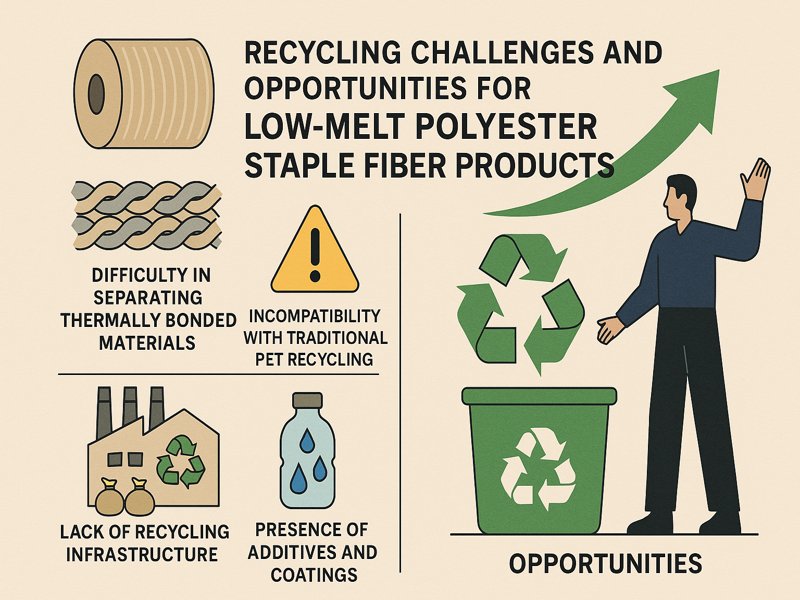The heat-bonding synthetic fiber known as low-melt polyester staple fiber (LMPSF) is utilized in nonwovens, wadding, and filters. Melting at 110–180°C, it bonds materials efficiently. With rising sustainability concerns, LMPSF’s recyclability is under review, revealing both challenges and promising opportunities.
Understanding LMPSF and Its Applications
LMPSF is made by blending polyester polymers with different melting points. During processing, the low-melt component softens and bonds with other fibers or materials, creating structural integrity without needing additional adhesives. This property has made LMPSF valuable across several sectors:
- Automotive: Acoustic panels, insulation, trunk linings
- Home textiles: Quilts, pillows, cushions
- Construction: Thermal and sound insulation materials
- Filtration: Air and liquid filter media
- Apparel: Interlinings and wadding in jackets and outerwear
While these applications deliver performance and cost advantages, their mixed-material composition often complicates recycling efforts.

Recycling Challenges of LMPSF Products
Difficulty in Separating Thermally Bonded Materials
One of the core features of LMPSF is its ability to bind other fibers during heat treatment. While ideal for manufacturing strong nonwoven fabrics, this characteristic becomes a problem at the end of the product’s life. It is practically impossible to separate fibers mechanically without causing damage to the material once they have been thermally bonded.This makes it difficult to recycle LMPSF-based products using conventional methods like shredding or mechanical reprocessing.
Incompatibility with Traditional PET Recycling
LMPSF is typically blended with other fibers like regular PET, polypropylene (PP), or natural fibers (cotton, wool). However, its lower melting point poses a risk when such blends are recycled alongside standard PET products. The low-melt component can melt prematurely during recycling processes, leading to clogs in machinery, degradation of PET quality, or contamination of recycled resin batches.
Lack of Recycling Infrastructure
While the recycling of PET bottles and standard polyester fibers has gained momentum, LMPSF still lacks a dedicated recycling stream. Many municipal or industrial recycling systems are not equipped to handle specialty fibers with varying melting points or hybrid compositions. Without clear labeling or product design considerations, these materials are often sorted as non-recyclable waste and incinerated or landfilled.
Presence of Additives and Coatings
Some LMPSF products are treated with flame retardants, dyes, adhesives, or water-repellent coatings to meet specific industry needs. These chemical additives not only complicate the mechanical recycling process but also restrict chemical recycling due to potential toxic byproducts or processing challenges. Removing or neutralizing these additives often requires expensive, energy-intensive pretreatment.
Emerging Recycling Solutions for LMPSF
Despite these hurdles, the recycling of LMPSF is not a lost cause. Researchers, manufacturers, and recyclers are exploring several innovative approaches to repurpose these fibers effectively.
Mechanical Recycling for Specific LMPSF Products
For certain mono-material LMPSF applications—such as thermal bonded batting used in furniture—it is possible to collect, shred, and reuse the fibers in low-grade applications. While this downcycling doesn’t return fibers to their original quality, it still diverts waste from landfills and reduces virgin material usage.
Manufacturers can establish closed-loop recycling systems within factories, where production scrap or offcuts are reused in non-critical components like insulation pads or filler materials.
Chemical Recycling Techniques
Chemical recycling holds significant promise for LMPSF, especially when products are composed of compatible polyester materials. LMPSF can be broken down into its monomers or oligomers by processes like glycolysis, methanolysis, and hydrolysis. These can subsequently be purified and repolymerized into fresh polyester.
The advantage of chemical recycling is its potential to remove additives and contaminants, allowing high-purity recycled outputs. However, these methods are still in development for LMPSF-specific challenges and must overcome scalability and cost concerns.
Blending with Virgin Materials
Another practical approach involves blending recycled LMPSF with virgin fibers to create composite materials that retain acceptable performance levels. These blended materials can be used in nonwoven applications where strength and aesthetics are less critical, such as construction insulation or horticultural textiles.
This strategy reduces waste while also easing pressure on raw material consumption, provided that the recycled fibers are clean and mechanically compatible.
Thermal Recovery and Waste-to-Energy
In cases where recycling is infeasible, thermal recovery can be considered. The calorific value of polyester allows it to be used as a fuel substitute in energy-intensive industries like cement production. While this doesn’t constitute true material recycling, it does offer a way to extract energy from waste while reducing fossil fuel use.
Some advanced pyrolysis technologies are also being explored to convert polyester-based materials into fuels, syngas, or useful chemicals. These systems may eventually offer scalable waste management solutions for complex LMPSF products.
Opportunities for Sustainable Design and Circularity
To improve recyclability, the design stage of LMPSF products must prioritize end-of-life considerations. Manufacturers and designers can tap into the following opportunities:
Mono-Material Product Development
Designing LMPSF-based products using only polyester or compatible copolymers eliminates cross-material contamination. Monomaterial products are far easier to recycle mechanically or chemically, leading to more sustainable outcomes.
By avoiding the use of incompatible polymers like polypropylene or polyethylene in composite materials, manufacturers can significantly improve recycling potential.
Use of Recycled Content in LMPSF
Recent advances have made it possible to produce LMPSF from recycled PET flakes. This strengthens the entire recycling ecosystem by lowering the production’s carbon impact and raising demand for post-consumer PET.
Incorporating recycled content into LMPSF production encourages circularity and sends a market signal to support better plastic collection and recycling infrastructure.
Design for Disassembly
Some new product architectures are exploring ways to mechanically join components without permanent thermal bonding. If low-melt bonding is used selectively—or designed to be reversible—products can be taken apart at end-of-life, sorted more easily, and reprocessed with minimal loss.
This approach is particularly relevant in automotive interiors and mattress construction, where recyclability is becoming a procurement requirement.
Industry Collaborations and Take-Back Programs
Textile manufacturers, automotive suppliers, and home goods brands are starting to invest in take-back schemes and recycling partnerships. By collecting LMPSF-based products post-consumer and sending them to specialized recyclers, brands can close the loop and reduce landfill contributions.
Such collaborations can also help aggregate sufficient volumes of recyclable LMPSF waste, making recycling efforts more economically viable.
Market Outlook and Policy Implications
The push for sustainability in the textile, automotive, and construction industries is driving interest in recyclable and low-impact materials. Governments worldwide are enacting stricter Extended Producer Responsibility (EPR) laws, and green procurement guidelines are becoming more common.
These trends present an opportunity for LMPSF producers to differentiate through innovation, offering recyclable products or circular services that meet evolving regulatory and consumer expectations.
Investment in recycling infrastructure, research into LMPSF-compatible recycling methods, and collaboration across the value chain are essential to unlock the full potential of these specialty fibers.
Low-melt polyester staple fiber products offer innovative bonding solutions but pose recycling challenges due to their thermal properties. Still, combining mechanical, chemical, and energy recovery methods—along with smarter design and policy—can support a circular future. Now is the time for manufacturers, recyclers, and policymakers to invest in scalable recycling solutions that cut waste and boost long-term sustainability.

